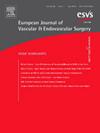主动脉瘤下腔静脉血管内修复术的围手术期和中期效果
IF 5.7
1区 医学
Q1 PERIPHERAL VASCULAR DISEASE
European Journal of Vascular and Endovascular Surgery
Pub Date : 2025-04-01
DOI:10.1016/j.ejvs.2024.11.019
引用次数: 0
摘要
这项回顾性观察研究使用了荷兰两家大型医院的临床数据,评估了对并腹主动脉瘤(JAAA)进行血管腔内主动脉修补术的中期疗效,并对腹腔上和腹腔下封堵术进行了比较。由于近端封堵时间较长,因此腹腔上封堵被认为具有优势,但发病率通常较高。研究发现,腹腔上近端封堵术治疗 JAAA 安全有效,围手术期和中期疗效与腹腔下近端封堵术相当。今后需要进行研究和长期随访,以确定腹腔上封堵是否能更持久地排除动脉瘤囊:本研究的目的是对腹主动脉瘤(JAAA)的瓣膜化血管内主动脉修补术(FEVAR)的围手术期和中期结果(包括瘤囊动态)进行调查,并对腹腔上和腹腔下封堵术进行比较。由于近端封堵区更长,因此心包上封堵可能更具优势,但手术过程更复杂,并发症风险更高。此外,心包上封堵是否真的能提高耐久性,目前还不得而知:方法:纳入2008年至2021年期间在荷兰两家医院接受选择性FEVAR治疗JAAA的患者。心包上封堵的定义是在第 5 或第 6 区封堵,并纳入腹腔轴。腹腔下封堵的定义低于 6 区。主要终点包括围手术期结果。次要终点包括一年的动脉瘤囊动态、无二次干预、五年的死亡率以及随着时间推移的动脉瘤囊动态:在167名患者中,78人(46.7%)在腹腔下水平进行了近端封堵,89人(53.3%)在腹腔上水平进行了近端封堵。腹腔上组的近端封堵长度中位数为 37 毫米(四分位间距 [IQR] 28 - 52),腹腔下组的近端封堵长度中位数为 26 毫米(四分位间距 [IQR] 19 - 34)。主动脉瓣上腔封堵的患者更多曾进行过血管内主动脉瘤修复(31% 对 12%;P = .004)。Ⅲc型内漏只发生在接受主动脉腔上封堵术的患者中(6% 对 0%;P = 0.03)。两组患者的其他围手术期并发症和死亡率相似。此外,在动脉瘤囊一年的动态变化、无二次干预、五年死亡率和囊的长期动态变化方面也未发现明显差异:结论:近端动脉瘤囊上封堵术和动脉瘤囊下封堵术显示出相似的中期结果,包括动脉瘤囊的动态变化,尽管动脉瘤囊上封堵术的手术复杂程度更高。心腔上封堵术的 30 天 IIIc 型内漏率较高,但五年二次干预率没有差异。从理论上讲,随着时间的推移,封堵区会逐渐扩张,因此心包上封堵术可能具有优势,但未来还需要进行五年以上的随访研究,以确定其对长期动脉瘤囊排除的影响。本文章由计算机程序翻译,如有差异,请以英文原文为准。
Peri-operative and Midterm Results of Supracoeliac versus Infracoeliac Sealing for Fenestrated Endovascular Aortic Repair of Juxtarenal Aortic Aneurysms
Objective
The aim of this study was to investigate peri-operative and midterm outcomes, including sac dynamics, of fenestrated endovascular aortic repair (F-EVAR) for juxtarenal abdominal aortic aneurysms (JAAAs), comparing supracoeliac with infracoeliac sealing. Supracoeliac sealing may offer an advantage due to a longer proximal sealing zone, but is associated with a more complex procedure and increased risk of complications. Furthermore, it is unknown whether supracoeliac sealing actually leads to increased durability.
Methods
Patients undergoing elective F-EVAR for JAAAs from 2008 – 2021 at two hospitals in the Netherlands were included. The definition of supracoeliac sealing was sealing in zone 5 or 6, with incorporation of the coeliac axis. Infracoeliac sealing was defined below zone 6. The primary endpoints included peri-operative outcomes. Secondary endpoints included one year aneurysm sac dynamics, freedom from secondary intervention, five year mortality rate, and sac dynamics over time.
Results
Among 167 patients, 78 (46.7%) had a proximal sealing at an infracoeliac level and 89 (53.3%) at a supracoeliac level. The median proximal sealing length was 37 (interquartile range [IQR] 28, 52) mm for the supracoeliac group and 26 (IQR 19, 34) mm for the infracoeliac group. Patients with supracoeliac sealing had more often had prior endovascular aortic aneurysm repair (31% vs. 12%; p = .004). Type IIIc endoleaks only occurred in patients with supracoeliac sealing (7% vs. 0%; p = .032). Other peri-operative complications and mortality rates were similar between the groups. Furthermore, no significant differences were found in one year aneurysm sac dynamics, freedom from secondary interventions, five year mortality rate, and sac dynamics over time.
Conclusion
Proximal supracoeliac and infracoeliac sealing showed similar midterm outcomes, including sac dynamics, despite the higher procedural complexity of supracoeliac sealing. Supracoeliac sealing had a higher rate of 30 day type IIIc endoleak, but no difference in five year secondary intervention rate. Theoretically, supracoeliac sealing may be advantageous as sealing zones dilate over time, although future studies with longer than five year follow up are needed to determine its impact on long term aneurysm sac exclusion.
求助全文
通过发布文献求助,成功后即可免费获取论文全文。
去求助
来源期刊
CiteScore
6.80
自引率
15.80%
发文量
471
审稿时长
66 days
期刊介绍:
The European Journal of Vascular and Endovascular Surgery is aimed primarily at vascular surgeons dealing with patients with arterial, venous and lymphatic diseases. Contributions are included on the diagnosis, investigation and management of these vascular disorders. Papers that consider the technical aspects of vascular surgery are encouraged, and the journal includes invited state-of-the-art articles.
Reflecting the increasing importance of endovascular techniques in the management of vascular diseases and the value of closer collaboration between the vascular surgeon and the vascular radiologist, the journal has now extended its scope to encompass the growing number of contributions from this exciting field. Articles describing endovascular method and their critical evaluation are included, as well as reports on the emerging technology associated with this field.

 求助内容:
求助内容: 应助结果提醒方式:
应助结果提醒方式:


